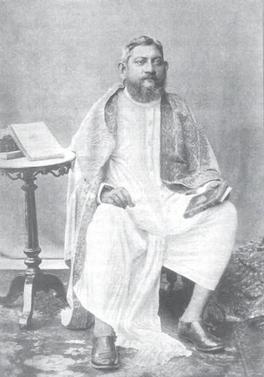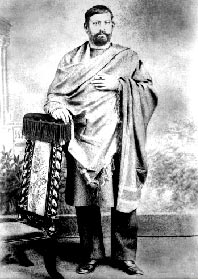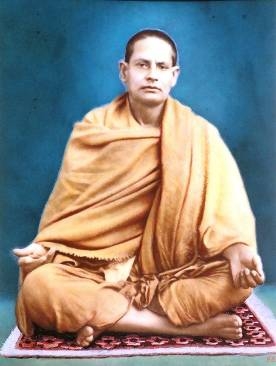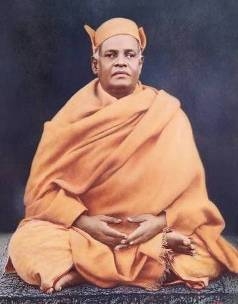
Chaitanya Mahaprabhu was a 15th-century Indian Hindu saint from Bengal who is considered to be the combined avatar of Radha and Krishna by his disciples and various scriptures. Chaitanya Mahaprabhu's mode of worshipping Krishna with bhajan-kirtan and dance had a profound effect on Vaishnavism in Bengal. He was also the chief proponent of the Vedantic philosophy of Achintya Bheda Abheda Tattva. Mahaprabhu founded Gaudiya Vaishnavism. He expounded Bhakti yoga and popularised the chanting of the Hare Krishna Maha-mantra. He composed the Shikshashtakam.

Bankim Chandra Chattopadhyay was an Indian novelist, poet, essayist and journalist. He was the author of the 1882 Bengali language novel Anandamath, which is one of the landmarks of modern Bengali and Indian literature. He was the composer of Vande Mataram, written in highly Sanskritised Bengali, personifying Bengal as a mother goddess and inspiring activists during the Indian Independence Movement. Chattopadhayay wrote fourteen novels and many serious, serio-comic, satirical, scientific and critical treatises in Bengali. He is known as Sahitya Samrat in Bengali.

Sri Sarada Devi, born Kshemankari / Thakurmani / Saradamani Mukhopadhyay, was the wife and spiritual consort of Ramakrishna Paramahamsa, a nineteenth-century Hindu mystic. Sarada Devi is also reverentially addressed as the Holy Mother by the followers of the Sri Ramakrishna monastic order. The Sri Sarada Math and Ramakrishna Sarada Mission situated at Dakshineshwar is based on the ideals and life of Sarada Devi. She played an important role in the growth of the Ramakrishna Movement.

Shuddhananda who was the fifth president of the Ramakrishna Order, was a direct monastic disciple of Vivekananda. He joined the Ramakrishna Math in 1897. He became a trustee of Ramakrishna Math and a member of the governing body of Ramakrishna Mission in May 1903. He also took up the editorship of the Bengali magazine called Udbodhan for sometime. He was appointed as the secretary of the math and the mission in 1927 and as the vice president in 1937. In 1938, he became the president of the order. His tenure was short, as he died in 1938. He is renowned in the literary circles to have translated most of Vivekananda's original works from English to Bengali.

Mahendranath Gupta, , was a disciple of Ramakrishna and a great mystic himself. He was the author of Sri Sri Ramakrishna Kathamrita, a Bengali classic; in English, it is known as The Gospel of Sri Ramakrishna. He was also an early teacher to Paramahansa Yogananda, a famous 20th-century yogi, guru and philosopher. In his autobiography, Yogananda noted that Gupta ran a small boys' high school in Kolkata, and he recounted their visits, as they often traveled to the Dakshineshwar Kali Temple together. Having a devotional nature, Gupta worshipped the Divine Mother in the form of Kali, and often reflected the wisdom of his guru Ramakrishna in his daily life and mannerisms. Yogananda reverentially regarded Gupta's spirituality, calling him an "Incarnation of purity" and "the greatest man of humility I ever knew."Paul Brunton also narratives a meeting with Mahendra, in his famous memoir, 'A search in secret India'.

Ramakrishna Paramhansa Deva had sixteen direct disciples who became monks of the Ramakrishna Order; they are often considered his apostles. In the Ramakrishna-Vivekananda movement, the apostles have played an important role. Apart from Swami Vivekananda, the direct disciples or apostles of Ramakrishna were as follows.

Girish Chandra Ghosh was a Bengali actor, director, and writer. He was largely responsible for the golden age of Bengali theatre. He cofounded the Great National Theatre, the first Bengali professional theatre company in 1872, wrote nearly 40 plays and acted and directed many more, and later in life became a noted householder disciple of Sri Ramakrishna.

Balaram Bose was one of the prominent householder disciples of Ramakrishna Paramahamsa. He was the son of Radhamohan Bose. He is often referred in The Gospel of Sri Ramakrishna. Ramakrishna often visited his house and participated in kirtana and other devotional functions. Sri Maa Sarada Devi and some other devotees of the master, including Swami Adbhutananda lived in the house of Balaram Bose after the master's death. He was a great philanthropist and donated regularly to government and civilian organizations.

Surendra Nath Mitra aka Surendranath Mitra was one of the prominent devotees of Sri Ramakrishna Paramahamsa. He came from a very prosperous background and had the fortune of sponsoring the expenditures of the Master and his devotees when the Master lived in Calcutta in his last days. He was also known as Suresh Chandra Mitra, but Sri Ramakrishna called him "Surendra". Suresh lived in Simulia Street, the same locality as Narendranath.

Sri Sri Ramakrishna Kathamrita is a Bengali five-volume work by Mahendranath Gupta (1854–1932) which recounts conversations and activities of the 19th century Indian mystic Ramakrishna, and published consecutively in years 1902, 1904, 1908, 1910 and 1932. The Kathamrita is regarded as a Bengali classic and revered among the followers as a sacred scripture. Its expurgated translation into English is entitled The Gospel of Sri Ramakrishna (1942).

Adbhutananda, born Rakhturam, was a direct monastic disciple of Ramakrishna, a Yogi of nineteenth century Bengal. He is familiarly known as Latu Maharaj among the followers of Ramakrishna. Adbhutananda was the first monastic disciple to come to Ramakrishna. While most of Ramakrishna's direct disciples came from the Bengali intelligentsia, Adbhutananda's lack of formal education made him unique amongst them. He was a servant boy of a devotee of Ramakrishna, and he later became his monastic disciple. Though unlettered, Adbhutananda was considered as a monk with great spiritual insight by Ramakrishna's followers, and Vivekananda regarded him as "the greatest miracle of Ramakrishna".

Ramakrishna Sarada Math is a religious monastic order, considered part of the Hindu reform movements. It was established in 1929 at Bagbazar, Kolkata.

Durga Charan Nag better known as Nag Mahasaya, was born in 1846 in the village of Deobhog in East Bengal, now Bangladesh. He was one of the householder disciples of Sri Ramakrishna Paramahansa. Sri Ramakrishna called him "a blazing fire" when he first saw him. According to the other disciples of Sri Ramakrishna, most notable among them being Swami Vivekananda, he was a shining example of renunciation and love for God. He shunned material wealth and regarded every human being as God on earth. He lived on a meager income, but spent most of it on serving the poor, his guests, and monks and ascetics.

Akshay Kumar Sen was one of the lay disciples of Sri Ramakrishna, the 19th century Bengali mystic and saint. He was the author of the book Sri Ramkrishna Punthi, a long narrative poem on the life and teachings of one of the most illustrious figures of 19th-century India. After reading the work, Swami Vivekananda wrote from the United States to a brother monk in India, "Give Akshaya a hundred thousand hearty embraces from me. Through his pen Sri Ramakrishna is manifesting himself. Blessed is Akshaya."

Baburam Maharaj (Swami Premananda) (Bengali: বাবুরাম মহারাজ; 10 December 1861 – 30 July 1918) was a direct disciple of Ramakrishna, the 19th-century saint and mystic from Bengal, India. He was born in Antpur in the Hoogly district of Bengal in the year 1861. Baburam, as he was called in his pre monastic days, was also related to Balaram Bose, a leading householder disciple of Ramakrishna. He was given the name of Premananda or "joy of divine love" by his brother disciple Vivekananda. He had a notable contribution during the initial days of Ramakrishna Mission as he managed the whole affairs of Belur Math from 1902 to 1916. He also mentored young spiritual aspirants.

Saradananda, also known as Swami Saradananda, was born as Sarat Chandra Chakravarty in 1865, and was one of the direct monastic disciples of Ramakrishna. He was the first Secretary of the Ramakrishna Math and Ramakrishna Mission, a post which he held until his death in 1927. He established the Udbodhan house in the Bagbazar area of Calcutta, which was built primarily for the stay of Sri Sarada Devi in Calcutta, from where he used to publish the Bengali magazine Udbodhan. There he wrote Sri Sri Ramakrishna Lilaprasanga in Bengali, on the life of Ramakrishna, which was translated into English as Sri Ramakrishna, the Great Master. He is believed to be reincarnation of Saint Peter and he allegedly went into Samadhi when he was in the Saint Peter Church and said that "I remembered my past" and wrote in his diary that "Saint Peter again."

Trigunatitananda, premonastic name Sarada Prasanna Mitra, was a direct disciple of Ramakrishna, the 19th-century Indian Hindu mystic and sant. He established the monthly Bengali magazine Udbodhan of Ramakrishna Math and later, at the behest of Vivekananda, went to America in 1902 and took charge of the San Francisco centre.

Golap Ma was a direct householder disciple of Sri Ramakrishna, the 19th-century mystic and saint, and a foremost companion of Sri Sarada Devi, his spiritual consort and the Holy Mother of Ramakrishna Order, along with her other companion, Yogin Ma. Her real name was Annapurna Devi, or Golap Sundari Devi. She was also referred to as a "grief-stricken Brahmani" in the Gospel of Sri Ramakrishna. She played a very important role in the early development of the Sri Ramakrishna movement and stayed, until her death, in Udbodhan, the house where the Holy Mother stayed in Calcutta. She was popular as Golap Ma among the devotees of the Ramakrishna Order.

Gopaler Ma was a devotee and a householder disciple of Sri Ramakrishna, the saint and mystic from Bengal. Her birth name was Aghoremani Devi, but she came to be known as Gopaler Ma among the devotees of Sri Ramakrishna, owing to her intense motherly love for Sri Ramakrishna as "Gopala" or baby Krishna. She was famous for her divine visions of Lord Krishna as a baby and her devotion to the ideals of Sri Ramakrishna. In her later years, she was very close to Swami Vivekananda and Sister Nivedita. She spent the last few years of her life with Sister Nivedita.

Achalananda, popularly known as Kedar Baba, was a direct monastic disciple of Vivekananda and the founder of Ramakrishna Mission Home of Service, in Varanasi. He initially worked as a policeman, but was then influenced by the ideology of Vivekananda.




















